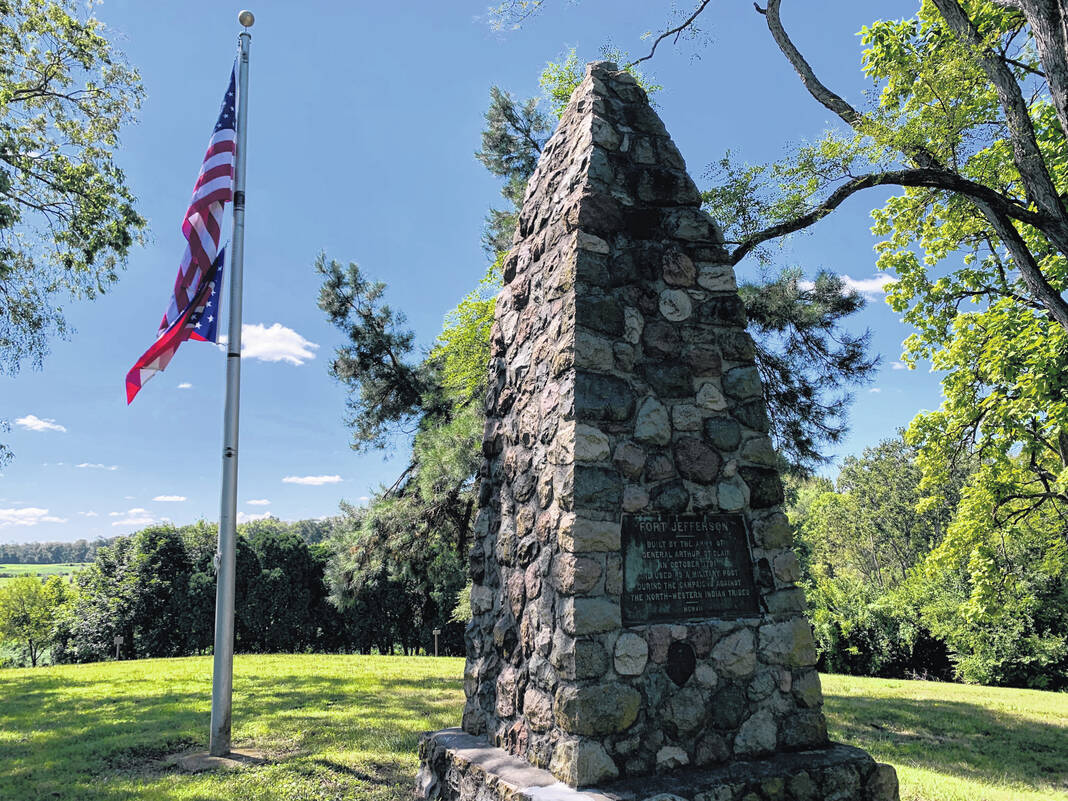
Ft. Jefferson once stood proudly south of Greenville along what is now State Route 121. A marker marks the spot of the fort.
Ryan Berry | Daily Advocate
GREENVILLE — Fort Jefferson has been forgotten for nearly 200 years after its existence. Part of the reason was due to historians and the public not understanding that the Ohio Indian War (1790-1795), of which Fort Jefferson (1791-1797) was a part, was a continuation of the Revolutionary War on the frontier and a major cause of the War of 1812. The Native American’s defense of their homeland did not end in the area northwest of the Ohio River until the end of the War of 1812. The following summarizes the importance of Ft. Jefferson:
* The Congress and people of the United States began to accept the need for a well-trained peacetime standing army during the time of Ft. Jefferson’s existence After the Army suffered the worst defeat ever in which Ft. Jefferson played a major role, the fort housed the survivors of the First American Regiment and Second U.S. Infantry, who held on through persistence and resolve for two years in the middle of Indian Territory until Wayne’s Legion came to subdue the Native Americans. See the Eagle and Sword by Richard Kohn.
* Ft. Jefferson supported the Wayne Campaign through the battle of Fallen Timbers and the Treaty of Greenville.
* The history of the Ohio Indian War has been neglected for both groups involved, particularly the Native Americans or Westem Confederation of Indians. This Confederation included Wyandots, Delawares, Shawnees, Ottawas, Chippewas, Pottawattomies, Miami and Eel River, Weas, Piankasaws, Kickapoos, Kaskakias, and a few representatives at times from some other tribes. These groups fought to protect their homeland that had been acknowledged to be theirs in treaties signed in 1768 and 1784 (Stanwyx), 1785 (Mclntosh), 1786 (Finney), 1789 (Harmar).
* Secretary of War Knox tried to negotiate a treaty with the Natives before the Wayne Campaign in 1792-93. The Native Americans refused to treaty with the United States unless Ft. Jefferson was removed from their territory. They killed two of the treaty commissioners. Ft. Jefferson remained, so the campaign went forward.
* Ft. Jefferson was the supply base, staging area, and refuge for the survivors of the catastrophic St. Clair’s Defeat (Battle of the Wabash). Almost three times the number of casualties were the result of St. Clair’s Defeat compared to Custer’s Last Stand. More soldiers were killed at this battle, 637, than any battle in the American Revolution!
* After the battle, the soldiers who survived and retreated to Ft. Jefferson were under siege conditions and attacked five times in the next year of 1792. The garrison held out for two years while Wayne’s Legion was raised and trained.
* Initially, the United States did not trust any kind of a standing army, remembering the British soldiers stationed here. They wanted our security force to be militia. The experience of the events surrounding the existence of Ft. Jefferson showed the mistake of relying on undisciplined and poorly trained militia and short term “levies.” Today’s professional peacetime army was a result of the events surrounding Ft. Jefferson.
* Ft. Jefferson was somewhat unique in having horizontal curtain walls that formed barracks, rather than picket walls as an outer defense perimeter. Some of the frontier forts were constructed in this manner but not as many.
* Continuing to forget the tragedy of the devastation of the Native Americans and their heroic defense of their homeland makes truth and reconciliation more difficult.
The evidence presented above makes it clear, and recent historians agree, that Ft. Jefferson should be part of both the Revolutionary War and War of 1812. Historians have realized the forgotten war. These historians are now correcting the problem which had been that the dates of Ft. Jefferson are after the so called “end” of the Revolutionary War. These dates are based on the Treaty of Paris in 1783, without the recognition that the British were not following the Treaty by not relinquishing their forts in the Northwest because the U.S. was not paying reparations for loyalists as was agreed. In addition, Native treaties giving them the land were not being honored, so they kept on fighting to defend their homeland. Finally, in 1794 the British gave up their forts but continued to support the Native Americans up to the end of the War of 1812.
The Treaty of Paris in 1783 did not end the Revolutionary War on America’s frontier. History is organic. It needs to change and grow based on new research and understandings as part of our spirit of inquiry into the truth about the past. We have an opportunity to correct the myths and legends to reach the truth. Through this truth comes reconciliation. ln addition to this is the story of the new nation and government’s struggles with reaching the ideal goals of the Declaration of Independence embodied in the American Revolution and how our forefathers and mothers tried to implement the new United States Constitution written only four years before the building of Fort Jefferson.
The National Park District’s Report to Congress on the Historic Presentation of Revolutionary War and War of 1812 Sites in the United States in 2007 states the best reasons the Fort Jefferson site should be preserved:
* Beyond written histories, documents, novels, songs, and epic poetry, it is the preserved battlefield or historic site that provides visitors with their most compelling link to the past… The authentic place has power to establish and revitalize the bond between citizen and national history.
Without these places of pilgrimage, we are left with words and fading memory… Historians have only recently begun to evaluate devastation wrought on the tribal nations of America… Their inclusion helps move the accepted history of these wars from the realm of legend and myth into that of reality and continued understanding.
Information provided by Friends of Ft. Jefferson.




